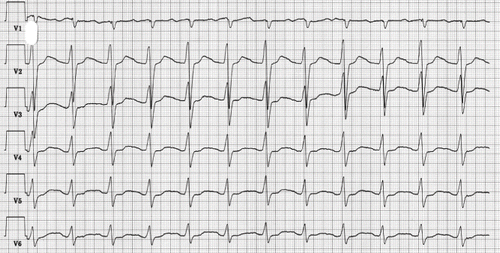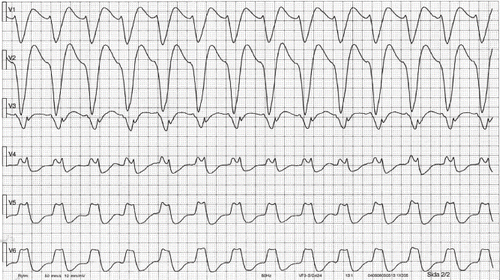To the Editor:
Overdose of venlafaxine is associated with a risk of seizures (Citation1, Citation2) and serotonin syndrome (Citation2). Cardiotoxic symptoms and CNS depression occur, but are less pronounced than in overdose of tricyclic antidepressants (Citation1). We present two cases of cardiotoxicity following venlavaxine overdoses.
Case 1
A 21-year-old woman was found comatose at 9:00 pm. She had collected a prescription for 196 Effexor® 75 mg extended-release capsules on the previous day (14.7 g venlafaxine), and most probably ingested them all. When the ambulance arrived she had seizures which were promptly controlled. At the emergency department she was unresponsive but opened her eyes in response to pain. Increased muscle tone, mydriasis and a body temperature of 38.3°C were noted. Blood pressure was 80/60 mmHg and pulse 146 beats/minute. ECG showed tachycardia, a prolonged QTc time and slightly widened QRS complexes (). Hypertonic sodium bicarbonate (200 mL of sodium bicarbonate 50 mg/mL) was given and the condition stabilized. However, at 10:50 pm she deteriorated and it was decided to intubate and ventilate. Gastric lavage was performed and charcoal administered. After a six-hour period of stability, the ECG suddenly showed ventricular tachycardia (). Cardioversion was performed and sodium bicarbonate (100 mL of sodium bicarbonate 50 mg/mL) and metoprolol (2.5 mg IV) were given. The ECG pattern improved but the blood pressure decreased. At 5:30 am she had a cardiac arrest. Intensive resuscitation was discontinued at 9:10 am. Autopsy performed 48 hours after death revealed high concentrations of venlafaxine and its metabolite O-desmethylvenlafaxine (95 and 8 μg/mL, respectively) in femoral blood.
Case 2
A 39-year-old woman ingested a large undefinable amount venlafaxine and 2 to 3 tablets of propiomazine between 9:00 pm and 11:00 pm. She was found at 2:30 pm the following day, disoriented but able to speak. An ambulance arrived at 4:00 pm. Systolic blood pressure was 80 mmHg and pulse 150 beats/minute. At the emergency department, the patient was agitated and the ECG displayed tachycardia and slightly widened QRS complexes (106 ms). Peripheral pulses were not palpable. Hypertonic sodium bicarbonate (100 mL of sodium bicarbonate 50 mg/mL) and metoprolol (5 mg IV) were given and the pulse decreased to 60 beats/minute. Ten minutes later, ventricular fibrillation was confirmed. Immediate defibrillation resulted in conversion to ventricular tachycardia. Shortly afterwards ventricular fibrillation was noted again and defibrillation repeated. The patient was intubated and repeated injections of adrenaline, amiodarone and sodium bicarbonate (200 mL sodium bicarbonate 50 mg/mL on two occassions) were given. For a time there was an irregular arrythmia which yielded a pulse. Echocardiography showed reduced contractility and an ejection fraction of 20% to 25%. Another cardiac arrest occurred that was refractory to therapy and at 5:55 pm the resuscitation efforts was discontinued. Autopsy performed 48 hours after death revealed high concentrations of venlafaxine and O-desmethylvenlafaxine (79 and 17.7 μg/mL, respectively) in femoral blood. Dihydropropiomazine, a metabolite of propiomazine, was found in a therapeutic concentration (0.1 μg/mL). A gas chromatographic method was used for both post-mortem analyses of venlafaxine. The observed concentrations were among the highest reported ever (Citation3–5). Significant cardiotoxicity is unusual after venlafaxine overdose (Citation1,Citation2); however, isolated cases of fatal circulatory failure have been reported previously (Citation3).
References
- Whyte IM, Dawson AH, Buckley NA. Relative toxicity of venlafaxine and selective serotonin reuptake inhibitors in overdose compared to tricyclic antidepressants. Q J Med 2003; 96: 369–74
- Kelly CA, Dhaun N, Laing WJ, Strachan FE, Good AM, Bateman DN. Comparative toxicity of citalopram and the newer antidepressants after overdose. J Toxicol Clin Toxicol 2004; 42: 67–71
- Banham NDG. Fatal venlafaxine overdose. Med J Aust 1998; 169: 445, 448
- Long C, Crifasi J, Maginn D, Graham M, Teas S. Comparison of analytical methods in the determination of two venlafaxine fatalities. J Analyt Toxicol 1997; 21: 166–9
- Fantaskey A, Burkhart KK. A case report of venlafaxine toxicity. J Toxicol Clin Toxicol 1995; 33: 359–61

